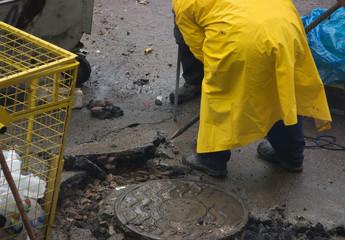Maintaining the integrity of asphalt surfaces is essential for ensuring the safety and durability of roads, driveways, and parking lots. However, over time, these surfaces can develop potholes and cracks due to various factors such as weather conditions, heavy traffic, or improper installation. Repairing these damages promptly is crucial to prevent further deterioration and potential accidents.
One effective method for quick fixes is using an asphalt cold patch. In this guide, we will explore what asphalt cold patch is, how it works, and the steps involved in using it to repair potholes and cracked surfaces.
Understanding Asphalt Cold Patch
Asphalt cold patch is a premixed, ready-to-use mixture specifically designed to repair potholes and damaged asphalt surfaces. Unlike hot mix asphalt, which requires heating and specialised equipment, cold patches can be used immediately without additional processing. It consists of a blend of asphalt, aggregate (stone or gravel), and additives that enhance its workability and bonding properties.
How Asphalt Cold Patch Works
The key factor contributing to the effectiveness of the asphalt cold patch is its bonding capability with the existing asphalt surface. This is made possible by incorporating special polymers and additives within the cold patch material, enabling it to adhere securely to the surrounding asphalt. As a result, a durable and waterproof repair is formed, capable of enduring temperature fluctuations, heavy traffic, and various environmental pressures when applied accurately.
Using Asphalt Cold Patch: Step-by-Step Guide
Repairing potholes and cracked surfaces using an asphalt cold patch can be straightforward if you follow the right steps. Here is a step-by-step guide to help you achieve a successful Asphalt Repair:
- Clean the area: Begin by removing any loose debris, dirt, or vegetation from the damaged area. Use a broom, brush, or air compressor to ensure a clean surface for optimal adhesion.
- Square the edges: Use a chisel, hammer, or saw to square the edges of the pothole or crack. Creating a clean and uniform edge helps achieve a smooth repair and prevents further spreading of the damage.
- Moisten the area: Spray water lightly over the repair area. This step helps prime the existing asphalt surface, creating a better bond with the cold patch material.
- Apply the cold patch: Open the container of asphalt cold patch and pour the material directly into the pothole or crack. Overfill the area slightly to compensate for any compaction during the next step.
- Compact the patch: Use a tamper, shovel, or hand tool to firmly compact the cold patch material. Ensure it is evenly spread and compacted to eliminate voids and achieve a smooth finish. Continue compacting until the patch is level with the surrounding surface.
- Seal the repair: To enhance the longevity of the repair further, consider applying a sealant over the patched area. This step will protect the repair from moisture and oxidation, prolonging its lifespan.
- Allow curing time: Give the repaired area sufficient time to cure. Follow the instructions provided by the manufacturer to determine the recommended curing time. Restricting traffic and avoiding placing heavy loads on the repair during this period is crucial.
- Final touches: After the patch has fully cured, inspect the repair for imperfections. Add cold patch material and compact as necessary to achieve a smooth and level surface if needed.
Benefits and Limitations of Asphalt Cold Patch
Asphalt cold patch offers several benefits, making it an attractive option for quick fixes. Some of the advantages include:
- Convenience: Cold patches can be used immediately, eliminating the need for specialised equipment or extensive preparation.
- Versatility: It can be applied in various weather conditions, including cold and wet environments.
- Durability: Cold patch forms a strong bond with the existing asphalt, providing a long-lasting repair that can withstand heavy traffic and harsh weather conditions.
However, it is important to note some limitations of the cold patch:
- Temporary solution: Cold patch repairs are temporary and may not provide the same longevity as hot mix asphalt repairs.
- Aesthetics: The appearance of cold patch repairs may differ slightly from the surrounding asphalt, especially over time, as the colour may fade or change.
- Size limitations: Cold patch is typically recommended for smaller repairs such as potholes and cracks. Larger areas or extensive damage may require alternative solutions.
Conclusion: Asphalt cold patch is a convenient and effective method for quickly repairing potholes and cracked surfaces. You can achieve a durable and long-lasting repair by following the step-by-step guide outlined in this article. However, it’s important to remember that cold patch repairs are temporary and may require further solutions like crack sealing. For more details and services, contact Line Marking Plus.
